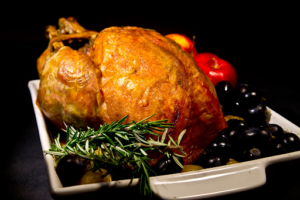With Thanksgiving and Christmas around the corner, it is time to prepare for the festive season. Whether you are the one who cooks for the festivities or the one who eats, we have all benefited from the Maillard reaction, more commonly known as the “browning” reaction.
The Maillard reaction was first described by a French physician and chemist, Louis Camille Maillard in 1912. He described the reaction between amino acids and sugars that take place at high temperatures (greater than 140℃ or ~280℉). In 1953, John Hodge, a chemist at the U.S. Department of Agriculture, published a paper examining the in-depth chemistry of the Maillard reaction. When you are roasting a turkey at high temperatures (above 140℃), the amino acids from proteins and sugars from carbohydrates will react and create new compounds with ring structures. These newly formed structures reflect light that gives the turkey that glistening brown color. These new compounds will continuously rearrange themselves to make more new compounds (over a thousand compounds have been identified), resulting in the complex flavors and aromas of a roasted turkey.
 Image source: compoundchem.com
Image source: compoundchem.com
Different aromas and flavors are created depending on the amino acid composition of the food, the temperature and cooking environment. Hence, the Maillard reaction in turkey-roasting does not produce the same aroma and taste as those found in roasted vegetables, the crust of a pumpkin pie, chocolate, toasted bread, grilled steak, and so on.
A dark side to the Maillard reaction happens at a higher temperature, usually above 200℃ or 400℉, when formation of carcinogenic/cancer-causing substances, such as acrylamide and 5-hydroxymethylfurfural (HMF), can also take place. Margareta et al from Stockholm University show that acrylamide is noticeably present in processed food, such as french fries and chips, that need highly elevated temperature for the cooking or manufacturing process. But after all, life is all about balance. So as long as you don’t go overboard with this type of food, our body is more than capable of neutralizing trace amounts of carcinogenic substances.
Next time you are roasting a turkey, now you know that there are different ring-structured compounds helping you to make it beautiful and flavorful!
Peer edited by Alison Earley
